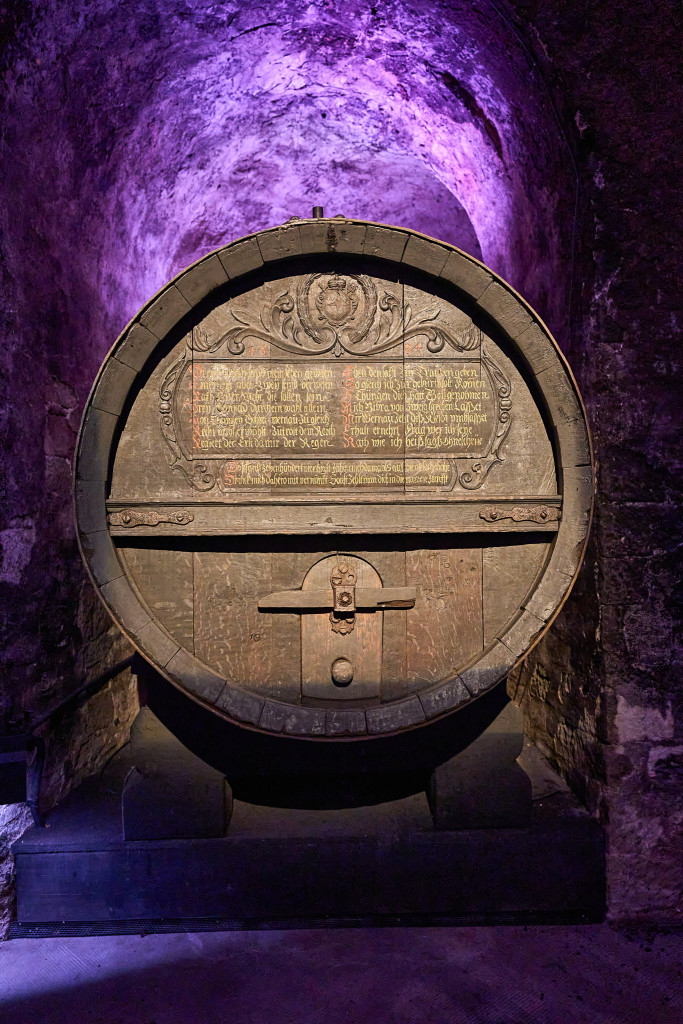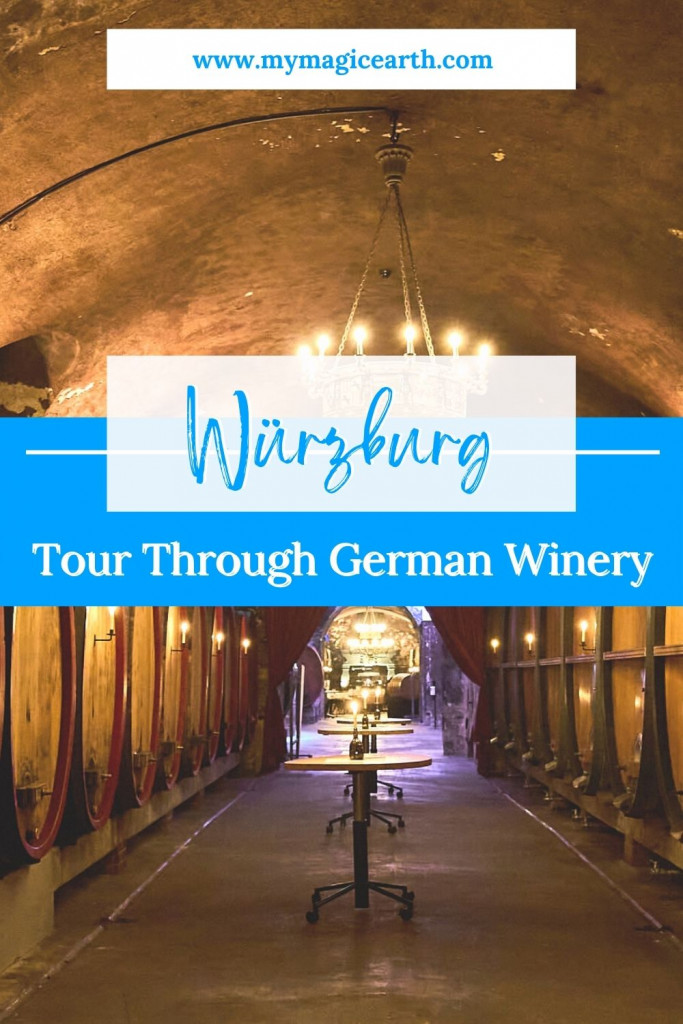Situated just below the Royal Residence, Würzburg’s Hofkeller (the Court Cellar of the former Prince Bishop, now the Royal Bavarian Court Cellar) is an expansive labyrinthine cellar spanning 4,557 m². While Bavaria is renowned for its diverse beer offerings, and events like Oktoberfest have made its beer world-famous, my curiosity is aroused about Würzburg, a significant Bavarian city, boasting an exceptional wine cellar with a history spanning over eight centuries.
The cellar tour took place on the last day of our Franconia weekend trip. Situated beneath the Würzburg Residence, it conveniently complements a visit to the magnificent castle. Amidst towering wine barrels and dimly lit passageways adorned with candlelight, we absorbed fascinating insights into the bastion of Franconian viticulture. Extending approximately one kilometre through meandering corridors in the earth, this wine cellar is a must-visit labyrinth where exquisite wines come to maturity when exploring the Franconian wine hub of Würzburg.


A short brief of History
The Hofkeller’s success story began in 1128 when Bishop Embricho of Würzburg generously donated land in Zell for the monastery’s construction, marking the inception of vineyard and cellar activities.
In 1540, Franconia boasted the finest wine of the era. During the Swedish War in 1684, the Swedes, recognizing the excellence of the wine from 1540, crafted a new barrel to preserve it – a barrel that stands today as the oldest in the cellar. Fast forward to 1719, Prince Bishop Schönborn, in the midst of constructing the Würzburg Residence, envisioned an exceptional wine cellar as part of the architectural plans.
A year later, the construction of the cellar started. In 1814, Würzburg joined Bavaria, and since then, the Prince Bishop’s Hofkeller, later the Royal Bavarian Hofkeller, and now the Bavarian State Winery (Staatlicher Hofkeller Würzburg), have remained under the ownership of the reigning power at the time.


Legendary wine year 1540
Our tour guide, armed with a witty sense of humour, skillfully unraveled the hidden tales of the wine in just 45 minutes.
The wine from 1540, thanks to an optimal climate and other favorable factors, earned the distinction of being the winery’s finest in history. In 1814, with Würzburg now under Bavarian rule, the winery followed suit. Bavaria’s King Ludwig II, upon learning of the old barrel, deemed it inadequately stored. Consequently, he transferred the wine to his residence but clandestinely sold the majority in bottles. The proceeds funded his whimsical castle near Munich. Following the King’s demise, the Bavarian government, seeking to settle his debts, auctioned off most of his assets, including the 1540 wine.
A Jewish wine trader named Simon from Wiesbaden in Germany seized the opportunity and purchased all the 1540 wine bottles. Escaping to London during World War II, Simon opened a wine shop to showcase his prized collections. Unfortunately, Hitler’s bombings also reached London, impacting his wine shop. Post-war, Simon’s descendants sifted through the ruins, discovering some intact 1540 wine bottles in a secure basement cellar.


The family invited ten famous wine experts to pinpoint the wine’s origin. Unfortunately, they could only taste the first glass as the remaining wine swiftly oxidised, adopting a vinegar-like taste. After identifying the wine, the family decided to send the remaining two bottles back to Hofkellar in Würzburg.
Surprisingly, Hofkellar didn’t believe the bottles contained wine from 1540. Two hospitals, which had their own wineries in Würzburg, opened one bottle and confirmed the wine was indeed from 1540. The second bottle is now the last known and remaining full bottle from this legendary vintage, kept in the basement of one of the hospitals, which is an elderly home today.
The giant wine barrier and the sponsored wine barrels
In the Hofkellar cellar in Würzburg, the barrels can hold up to 1200 litres of wine each. Many of these barrels are sponsored, with the names of the sponsors—whether companies or individuals—printed on them. Every year, the Hofkellar invites these sponsors to taste the new wine.
Towards the end of the cellar tour, our group came across a massive wine barrel. In the Middle Ages, servants were paid with wine, essentially receiving liquid wages. During that time, people preferred wine over sometimes contaminated water. Court servants who had a good relationship with the wine master could access higher-quality wine. To accommodate this, the cellar constructed a giant 50,000-litre barrel, storing wines of various grades. All servants received their wine from this shared barrel.



Types of Wines from Hofkeller in Würzburg
Due to climate considerations, wineries in the Würzburg region mainly produce white wines. The quality of these wines is determined by factors such as the harvest quantity and the location of the grape harvest, following the VDP-specific classifications. The Verband Deutscher Prädikatsweingüter (VDP) is a German organization dedicated to promoting the country’s finest wines and estates. Broadly, there are four types of wine: VDP. GROSSE LAGE, VDP. ERSTE LAGE, VDP. ORTSWEINE, and VDP. GUTSTEIN.
- VDP.GROSSE LAGE wine represents the pinnacle of quality among German vineyards. It features grape varieties that are characteristic of the region, carefully selected to meet the unique requirements of each individual vineyard.
- VDP.ERSTE LAGE wines convey the distinct character of a vineyard.
- VDP.ORTSWEINE wine is crafted from local grape varieties, capturing the essence of the region.
- VDP.GUTSWEIN wine serves as a unique expression of a winegrower’s signature. These wines are typically among the first to be bottled and released in a wine year, cultivated in the vineyards of the respective winery.
At the end of the guided tour, we tasted the VDP. ERSTE LAGE. Having stayed in Bamberg for three days, I can say that the wines from Würzburg are the best Franconian food pairing drink.
Travel Tips for Hofkeller in Würzburg
Join a tour
Individuals can currently participate in a cellar tour conducted in German. English-guided tours are offered for groups. Alternatively, you have the option to join a Guided Walking Tour with Franconian Wine, providing an affordable way to explore the old town and savor the local wines. All the wines mentioned above are available for purchase in the winery’s shop.
How to get to Würzburg by train
Würzburg is conveniently just an hour away by train from Frankfurt, making it an ideal day trip destination. You can find information about the railway on www.bahn.com. The Würzburg Residence is approximately a 20-minute walk from the station.
How to get to Würzburg by car
- If you’re traveling on the A7 from Ulm, take the Kitzingen exit and follow the B8 through Biebelried to reach Würzburg.
- If you’re approaching from Kassel on the A7, take the Estenfeld exit and proceed along the B19 dual carriageway for approximately 7 kilometers to reach Würzburg.
- Come on the A3 from Nuremberg, take the Rottendorf exit and follow the B8 to reach Würzburg.
- But if you are driving on the A3 from Frankfurt, take the Heidingsfeld exit.
In front of the Würzburg Residence, you’ll find the Residence car park (“Parkplatz Residenz”) offering 400 parking spaces.
Where to stay in Würzburg
Many hotels in the old town are within walking distance from the Würzburg Residence, Hofkeller, and Marienberg Fortification.
Booking.com


